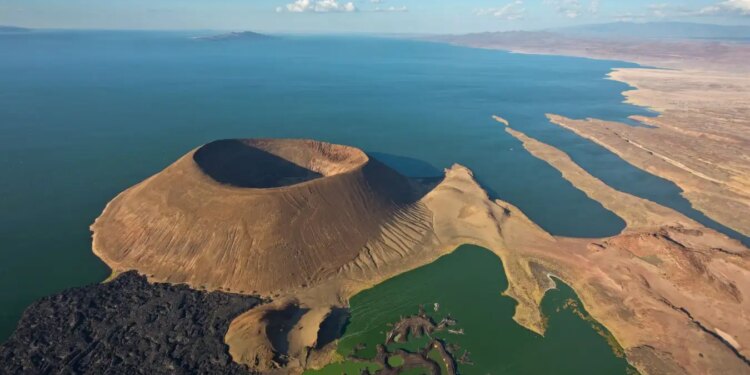
Aerial view of Nabuyatom crater south of Lake Turkana, Kenya
Martin Harvey/Alamy
A drying climate in East Africa reduced the amount of water in Kenya’s Lake Turkana over thousands of years, which unleashed earthquakes and volcanoes from underneath it. This hazard of climate change could eventually affect other bodies of water around the world as rain and drought patterns shift.
Lake Turkana is often called the cradle of humanity, as fossils up to 4.2 million years old have been found there from at least half a dozen hominin species, some of which appear to have co-existed. As the lake shrank over recent millennia, those human ancestors would have had to contend not only with a drying climate, but also with greater seismic activity.
“We postulate that there would have been more frequent earthquakes and more frequent volcanic eruptions during these time intervals,” says Christopher Scholz at Syracuse University in New York. “It would have compounded the already difficult conditions that can be observed today in that area.”
Lake Turkana is located between Kenya and Ethiopia in the Great Rift valley, a place where the continental plate is slowly splitting and spreading apart. It is the largest desert lake in the world, a body of greenish, salty water ringed by sandy shrublands and windy outcrops. But nine millennia ago, the lake was even bigger and surrounded by lush grasslands and pockets of forest.
Between 4000 and 6000 years ago, the climate became drier and the water levels in the lake dropped by 100 to 150 metres. Lower water levels create less pressure on the lakebed below, which can impact seismic activity. To determine the effects of this climate change, Scholz and his colleagues identified certain sediment layers corresponding to different time periods in cores that had previously been taken from the lakebed.
From a boat, they then performed sonar imaging at 27 faults on the lakebed to see how far the same sediment layers had been displaced from each other vertically on either side of each fault. They found as the climate dried, the sides of the faults began slipping past each other more quickly, increasing at an average rate of 0.17 millimetres per year.
“The main process is literally sort of clamping or unclamping this deformation zone, the zone of slip which results in earthquakes,” Scholz says. “A drier system and lower lake load allows it to slip more readily.”
Computer modelling suggested the reduced water mass also let more magma flow up from below the lake. One of the three volcanic islands in Lake Turkana erupted in 1888.
Scientists previously found lower sea levels increased volcanism at ocean ridges. But this is the first clear evidence of that happening around a lake, says Ken Macdonald at the University of California, Santa Barbara. “It’s almost like loosening the cork on a champagne bottle,” he says. “As you decrease that pressure, the magma is more likely to rise up in the crust and erupt.”
While increased rainfall due to climate change is now raising water levels in Lake Turkana once again, it would take thousands of years for that to significantly suppress earthquakes and volcanoes.
But assessments of seismic hazards should start considering how the changing climate might affect water levels, according to the study authors. And governments should take earthquake risk into account before they build or remove dams.
“They should put [seismometers] in before they make any huge changes,” Macdonald says.
Topics:
Source link : https://www.newscientist.com/article/2503579-when-rift-lakes-dry-up-it-can-cause-earthquakes-and-eruptions/?utm_campaign=RSS%7CNSNS&utm_source=NSNS&utm_medium=RSS&utm_content=home
Author :
Publish date : 2025-11-10 10:00:00
Copyright for syndicated content belongs to the linked Source.














